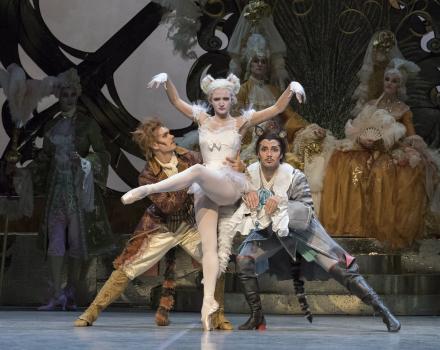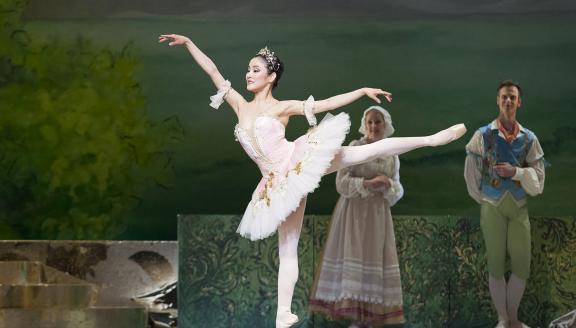

Tricked by the fairy of fear into touching a poisoned rose, a young princess falls into a deep and eternal sleep. Only one cure can break the hateful spell – true love’s first kiss.
The familiar story about the bewitched princess Aurora, the good and evil fairies, and the adventurous prince truly comes into its own as a ballet. The stunning costumes and sets evoke a richly colourful fairy-tale world, which will enthrall the entire audience from young children to adults. Sleeping Beauty is an ideal first experience of ballet for a child.
Cast
|
Morningstar
|
Eun-Ji Ha
|
|---|---|
|
Prince Désiré
|
Michal Krčmář
|
|
Carabosse, lady
|
Rebecca King
|
|
Carabosse, man
|
Giuseppe Martino
|
|
Syrene, the Fairy of Love
|
Hanako Matsune
|
|
Volante, the Fairy of Courage
|
Salla Eerola
|
|
Grazia, the Fairy of Joy and Beauty
|
Sara Saviola
|
|
Babette, Aurora's cousin
|
Valeria Quintana
|
|
Prince of the West
|
Wilfried Jacobs
|
|
Golden Deer
|
Frans Valkama
|
|
Orchestra
|
Finnish National Opera Orchestra
|
| ... | |
|
Music
|
Pyotr Ilyich Tchaikovsky
|
|---|---|
|
Conductor
|
Pietro Rizzo
|
|
Sets
|
Minna Wallenius
|
|
Lighting
|
Eric Loustau-Carrere
|
|
Costumes
|
Erika Turunen
|
|
Make-Up Design
|
Tuija Luukkainen
|
|
Principal ballet mistress
|
Ingrid Němečková
|
|
Ballet masters
|
Joseph Kerwin, Tuuli Tuominen-Sandell
|
|
Ballet master, children and extras
|
Francis Guardia
|
|
Children’s instructor
|
Nora Nurminen
|
|
Dramaturgical consultant
|
Anneli Mäkelä
|
| ... | |
Video
The story
Prologue: A princess is born
Once upon a time there was an enchanted kingdom far, far away. The King and Queen, to their delight, had a daughter, Princess Aurora. Three fairies are invited to be her godmothers: Volante, the fairy of courage; Grazia, the fairy of joy and beauty; and the most powerful of the three, Syrene, the fairy of love. Each of them brings a wonderful gift to the Princess. Volante gives her a wise and pure unicorn, Grazia gives her beauty and a swarm of butterflies of happiness and joy. But just as Syrene is about to give her gift, in storms Carabosse, the fairy of fear. She launches into an enraged complaint to the King and Queen for not inviting her.
It is then discovered that Catalabutte, the Master of Ceremonies, had forgotten to send her the invitation. Furious, Carabosse curses the little Princess: one day she will prick her finger with a poisoned rose thorn and die! Fortunately, Syrene has not yet given her gift to the Princess. Now it is her turn, and her power commutes the curse. Although the Princess will prick her finger, she will not die. Instead, she will fall into a deep sleep for a hundred years and awaken when a Prince gives her love’s first kiss.
Terrified, the King orders every single rose bush in the kingdom to be destroyed. At the same time in a deep dungeon, Carabosse and her imps prepare a poisoned rose for Aurora.
Act I : Destiny
It is Princess Aurora’s sixteenth birthday, and the King has organized a splendid party. The handsome company includes also Aurora’s happy cousin, but above all there are four Princes, each from a different point of the compass, who have come to ask for her hand in marriage.
Suddenly, an old woman enshrouded in a robe appears in the crowd. She gives the Princess a blossoming rose. Aurora, never having seen such a wonderful flower before, takes it with fascination and dances while holding it in her hand.
The court, remembering Carabosse’s curse, is horrified, and everyone tries to take the rose from Aurora, but it is too late: the Princess has pricked herself! The poison takes effect, Aurora sinks to the floor, and the old woman casts aside her robe and is revealed as Carabosse! Believing Aurora to be dead, she makes her escape. Syrene reminds everyone that Aurora is not dead. She will now sleep for a hundred years to be awakened by love’s first kiss. The Princess is carried to her bed, and Syrene enchants the entire castle to fall asleep until the Princess wakes.
Act II : The Vision
One hundred years later, Prince Desiré is out hunting with his friends and courtiers. Suddenly he sees a golden deer. They all chase after the fabulous creature, but a herd of deer bars their passage. Approaching the golden deer, the Prince draws his bow, but then Syrene appears. The golden deer is her messenger.
Now alone with the Prince, the fairy presents him with an enchanted vision and allows him to enter the spell, where he can dance with Aurora. The Prince also learns that Aurora sleeps in a castle covered with wild roses, guarded by the fearsome Carabosse.
When the vision is dispelled, Syrene guides the Prince to the castle. He is challenged by Carabosse but defeats her. The young man kneels by the Princess’s bed and kisses her. She wakes, and so does the entire court. Thus love conquers fear.
Act III : The Wedding
Princess Aurora and Prince Desiré have invited numerous guests to their wedding, including Little Red Riding Hood, Puss in Boots and the Blue Bird. There is much rejoicing; love has triumphed over all.
– based on the script by Anneli Mäkelä
Insights
5 things to know about Sleeping Beauty
1° Beauty begins…
The Sleeping Beauty was performed for the very first time in 1829 at the Paris Opera to music by Ferdinand Herold and choreography by Jean Aumer. When the latter left the Opera, his ballets left the repertoire too.
The Sleeping Beauty, in its most famous version, was performed at the Marinsky Theatre in Saint Petersburg on 15 January 1890 – at a time when audiences there had somewhat lost interest in ballet. Ivan Vsevolojski, Intendant of the Imperial Theatres, librettist and costume designer, set out to recreate the glory of ballets from the past and did not stint on expenses. He commissioned a score from Piotr Tchaikovsky, the composer of Swan Lake and The Nutcracker, who sketched out the music in just 40 days. Marius Petipa created the choreography. These two artists were in frequent contact; Petipa gave Tchaikovsky precise and detailed instructions about the type and rhythm of the music, and what he thought it should express. The composer nonetheless kept his independence. The royal family had a preview of The Sleeping Beauty the day before the performance. ‘It's very pretty’ said Tsar Alexander III. He was right, and the ballet was an immediate popular success.
2° The story and the ballet
The ballet’s story is drawn from two famous fairy tales: Charles Perrault’s Les Contes de ma Mère l’Oye and Grimm’s Fairy Tales. The latter is quite similar to the ballet but there are some notable differences with Perrault’s tale, which is much less fantastical than the danced version.
There are some notable differences: there are seven fairies in Perrault's tale but only three fairies in ballet. In the fairy tale, Carabosse announces that ‘the Princess will prick her hand with a spindle’, while in the ballet it is a poisonous thorn of a rose. In the tale, the Prince is informed by a peasant that a Princess (whom the author leaves without a name) has been plunged into a deep sleep, while in the danced version he is guided to her by the fairy Lilac during a hunt with his courtiers. In the tale, there is no famous kiss to bring the princess back to life, but he instead kneels down beside Aurore (her name in the ballet) and looks at her with wonder.
The differences are especially acute at the end of the story, which takes an unexpected and rather terrifying turn. The Queen, the prince's mother, is an ogress. When the King dies and the Prince goes to war, the Queen asks her butler to server her the couple's two children, her grandchildren, Aurore and Petit Jour, for dinner. He disobeys her by killing a lamb and a kid goat instead. The Queen then wants to eat the Princess, but her butler serves her deer instead. One evening, the Queen hears the Princess and her two children downstairs. She realises she has been deceived and asks that they be thrown into a tank full of toads, vipers and various other snakes. The King returns at this precise moment and the Ogress throws herself into the tub in their stead.
3° The Nureyev legacy
The Sleeping Beauty is Tchaikovsky's longest ballet: it lasts almost four hours and so is often cut in performance. Several famous choreographers have worked on this ballet, including Ninette de Valois in the 1920s, Rudolf Nureyev in the 1960s and George Balanchine in the 1980s.
Nureyev played the role of the Prince in 1961 at only 21 years of age. He regarded The Sleeping Beauty as ‘the ballet of ballets’, the pinnacle of classical ballet and ‘the perfect accomplishment of symphonic dance’. He choreographed the ballet in 1966 for La Scala in Milan and introduced personal touches: the King's kingdom became a court with strict etiquette, no longer whimsical. The fairy Carabosse was portrayed as a sophisticated woman, the fairy Lilac as a young liberal aristocrat. In 1972, at the National Ballet of Canada, Nureyev developed the role of the Prince and added a long solo during the hunting scene.
4 ° The famous bits
5° An inner battle between love and fear
Javier Torres is the choreographer of this production of The Sleeping Beauty from the Finnish National Ballet. He is a former student of the Escuela Nacional de Danza Clásica in Mexico City and has been a professional dancer since 1984 and a dance teacher since 1988. After working in Mexico and Europe, he joined the Helsinki Dance Company in 1989. From 1992 to 2008, he was a dancer at the Finnish National Ballet. He has since created more than 20 choreographies, including eight ballets, for several companies.
For Torres, Aurore is faced with a choice between fear and love in this ballet: ‘In my vision of the Sleeping Beauty fairy tale, the actual drama takes place within the heart of the main character, Princess Aurore. Hence, all the characters we see on stage appear as incarnations of Aurora’s inner emotions – particularly Syrene, the fairy of love, and Carabosse, the witch of fear.’
It will take the Princess 100 years to be able to consciously choose love. ‘A choice we all have’, says Torres, ‘the conscious choice of true love in the face of fear’.
Gallery









